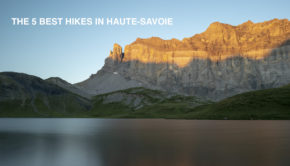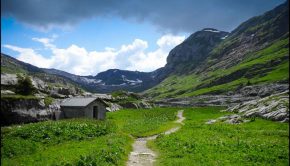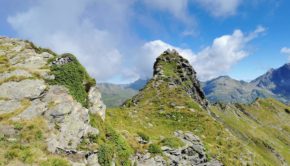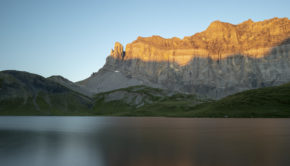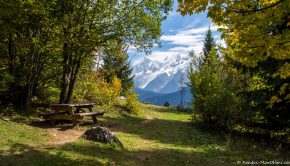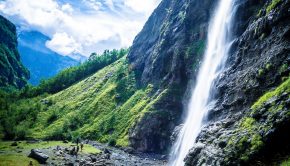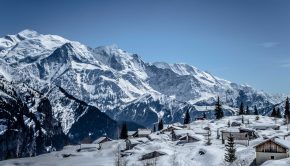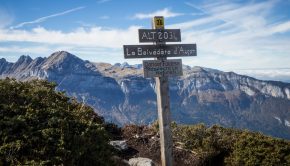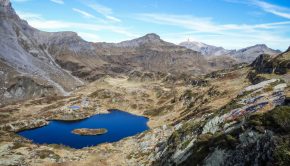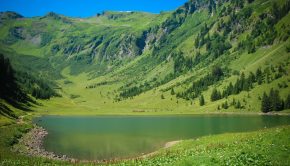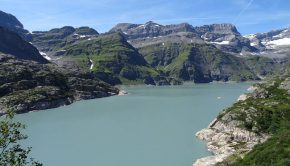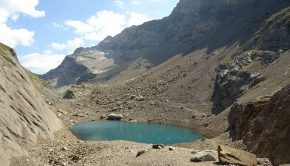The Giffre is a clay-limestone massif located in the south-east of Haute-Savoie and offers many hikes with breathtaking landscapes. The Giffre is in places a karstic relief, i. e. resulting from the hydrochemical and hydraulic erosion of soluble rocks, especially on the side of the Désert de Platé. The Giffre Massif includes three glaciers: the Ruan Glacier, the Prazon Glacier and the Tré-les-Eaux Glacier, which unfortunately are condemned to disappear before the end of the century due to global warming. The Giffre is the only massif with that of Mont-Blanc to offer hikes beyond 3000 m in altitude, with in particular the Buet, the Tour Sallière, the Dents du Midi or the Grand Mont Ruan. The massif is full of breathtaking landscapes, especially near Sixt-Fer-à-Cheval, a cirque classified as a Natural Reserve since 1977, offering magnificent views of waterfalls and rock giants such as the Tenneverge overlooking the cirque.

Browsing the "Giffre Massif" Tag
The 5 Best Hikes in Haute-Savoie
29 August 2023 | by Pierre-Alexandre
At the heart of the majestic French Alps, Haute-Savoie is a treasure trove for nature lovers and hiking enthusiasts. Its
Chalets de Sales, Col de la Portette, and Dérochoir
14 August 2023 | by Pierre-Alexandre
Located in the heart of the Fiz Massif between the Désert de Platé to the west and the Rocher des Fiz dominating Lac d’Anterne to the east, Chalets de Sales, set in the plain of the Grand Pré, constitute a tiny haven of tranquility that will delight the hiker
Pointe Noire de Pormenaz
12 September 2021 | by Pierre-Alexandre
Pointe Noire de Pormenaz is a summit of the Giffre massif overlooking Lac de Pormenaz situated below on its north-eastern flank. Located in a dominant position in relation to the Diosaz valley, Pointe Noire de Pormenaz remains a must-see in Haute-Savoie
Col and Lac d’Anterne
19 August 2019 | by Pierre-Alexandre
Located in the heart of the Sixt-Passy Nature Reserve, the Lac and Col d'Anterne remain a must in Haute-Savoie. Of glacial origin, Lac d'Anterne is a water reservoir of about 760,000 m3 at the foot of the majestic Rochers des Fiz
Chalets and Refuge de Varan
28 September 2017 | by Pierre-Alexandre
Aiguille de Varan is one of the main peaks of the Sallanches Valley, offering a magnificent view of the Mont Blanc Massif on one side and the Aravis Range on the other. I propose not to climb it, but to walk to the Refuge de Varan at its base. The itinerary begins at the Plateau d'Assy. A variant
Cirque du Fer-à-Cheval
5 September 2017 | by Pierre-Alexandre
Sixt Fer à Cheval is an immense corrie of 2 km in diameter delimited by imposing limestone cliffs from which spring many waterfalls. There are twelve in the summer, but it is in fact about thirty of these waterfalls that one can admire in the spring when the snow melts. The Fer à Cheval is a nature
Chalets d’Ayères
17 April 2017 | by Pierre-Alexandre
The Chalets d'Ayères constitute a beautiful scenery for a winter outing in Passy Plaine-Joux ski resort. Located under the Fiz Massif in front of the Mont Blanc Massif, the route
Belvédère d’Aujon
11 October 2015 | by Pierre-Alexandre
On the surface of some limestone soils occurs an erosion phenomenon called “lapiaz. ” It is a chemical (and not mechanical) action that causes this erosion, the result of which is the sculpture of the rock in more or less deep grooves. Depending on the degree of slope
Lac de Pormenaz
11 October 2015 | by Pierre-Alexandre
In the heart of Passy National Nature Reserve, Lac de Pormenaz, overlooked by the imposing eponymous Pointe Noire and Rochers des Fiz, is a must-see summer outing. The route easily leads to the Torrent du Souay to finally rise more frankly
Lac de Gers
1 August 2013 | by Pierre-Alexandre
Lac de Gers remains one of the countless treasures of the Giffre Massif. From Lac des Chambres to Lac d’Anterne and Lac de la Vogealle, the massif is full of wonders for the noblest pleasure of the hiker. Situated on the other side of the Rocher des Fiz, on the site of the Grand Massif
Bel Oiseau
22 August 2012 | by Pierre-Alexandre
Let’s get back to Lake Emosson, in the Canton of Valais, near Chamonix, for a walk much less renowned than the illustrious Cheval Blanc or Mont Buet: Bel Oiseau. Located at the end of the Barberine Valley and at the western end of Lake Emosso
Lac des Chambres
30 August 2011 | by Pierre-Alexandre
The Lac des Chambres, nestled at the foot of Pointe Rousse and Roches de la Couarra, is the objective of this walk. Formerly covered with late névé and icebergs, the Lac des Chambres today is a real “observatory” on the direct consequences of global warming
